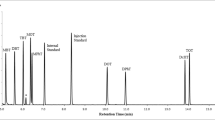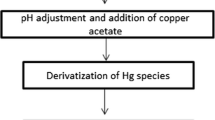Abstract
Benzothiazoles are high production volume chemicals widely used in many industrial and household applications. However, information on their occurrence in aquatic organisms is very limited, although a high level of bioaccumulation is expected. In this study and for the first time, a method was developed involving subcritical water extraction followed by solid-phase microextraction coupled to gas chromatography-ion trap-tandem mass spectrometry for the determination of five benzothiazoles in seafood. The repeatability and reproducibility of the method were under 21% (%RSD, n = 5, 100 ng g−1 (dw)), while method detection limits and method quantification limits were between 0.5 and 10 ng g−1 (dw) and 1 and 50 ng g−1 (dw), respectively. Ten widely consumed fish and shellfish species from the county of Tarragona (Catalonia, Spain) were selected in order to estimate dietary exposure and to assess the human health risks. The most frequently determined compounds were benzothiazole and 2-(methylthio)-benzothiazole, with squid being the species which showed the highest level of benzothiazole (82 ng g−1 (dw)). In terms of human exposure, the current concentrations of benzothiazoles found in fish and shellfish could not be compared to threshold values because of the lack of toxicological data.


Similar content being viewed by others
References
OECD. (Organisation of Economic Co-operation and Development). Screening information data set for high production volume chemicals, UNEP Chemicals. 1998. http://www.oecd.org/chemicalsafety/risk-assessment/33883530.pdf. Accessed 14 Dec 2016.
Herrero P, Borrull F, Pocurull E, Marcé RM. Efficient tandem solid-phase extraction and liquid chromatography-triple quadrupole mass spectrometry method to determine polar benzotriazole, benzothiazole and benzenesulfonamide contaminants in environmental water samples. J Chromatogr A. 2013;1309:22–32.
He G, Zhao B, Denison MS. Identification of benzothiazole derivatives and polycyclic aromatic hydrocarbons as aryl hydrocarbon receptor agonists present in tire extracts. Environ Toxicol Chem. 2011;30:1915–25.
Avagyan R, Luongo G, Thorsen G, Ostman C. Benzothiazole, benzotriazole, and their derivates in clothing textiles. A potential source of environmental pollutants and human exposure. Environ Sci Pollut Res Int. 2015;22:5842–9.
Hassan N, Verdes PV, Ruso JM. Assessment of interactions between four proteins and benzothiazole derivatives by DSC and CD. J Chem Thermodyn. 2011;43:399–404.
Keri RS, Patil MR, Patil SA, Budagumpi S. A comprehensive review in current developments of benzothiazole-based molecules in medicinal chemistry. Eur J Med Chem. 2015;89:207–51.
Asimakopoulos AG, Wang L, Thomaidis NS, Kannan K. Benzotriazoles and benzothiazoles in human urine from several countries: a perspective on occurrence, biotransformation, and human exposure. Environ Int. 2013;59:274–81.
EFSA, (European Food Safety Authority). Safety and efficacy of thiazoles, thiophene and thiazoline belonging to chemical group 29 when used as flavourings for all animal species. 2016; doi: 10.2903/j.efsa.2016.4441.
Ginsberg G, Toal B, Kurland T. Benzothiazole toxicity assessment in support of synthetic turf field human health risk assessment. J Toxicol Environ Health A. 2011;74:1175–83.
Zeng F, Sherry JP, Bols NC. Evaluating the toxic potential of benzothiazoles with the rainbow trout cell lines, RTgill-W1 and RTL-W1. Chemosphere. 2016;155:308–18.
Ye Y, Weiwei J, Na L, Mei M, Kaifeng R, Zijian W. Application of the SOS/umu test and high-content in vitro micronucleus test to determine genotoxicity and cytotoxicity of nine benzothiazoles. J Appl Toxicol. 2014;34:1400–8.
Abbott PJ, Renwick AG. WHO Food Additives Series: 50. Sulfur-containing heterocyclic compounds. 1998. http://www.inchem.org/documents/jecfa/jecmono/v50je12.htm#1.0. Accessed 15 Dec 2016.
Asimakopoulos AG, Ajibola A, Kannan K, Thomaidis NS. Occurrence and removal efficiencies of benzotriazoles and benzothiazoles in a wastewater treatment plant in Greece. Sci Total Environ. 2013;452–453:163–71.
Fries E. Determination of benzothiazole in untreated wastewater using polar-phase stir bar sorptive extraction and gas chromatography-mass spectrometry. Anal Chim Acta. 2011;689:65–8.
Reemtsma T, Fiehn O, Kalnowski G, Jekel M. Microbial transformation and biological effects of fungicide-derived benzothiazoles determined in industrial wastewater. Environ. Sci. Technol. 1995;29:478–85.
Stasinakis AS, Thomaidis NS, Arvaniti OS, Asimakopoulos AG, Samaras VG, Ajibola A, Mamais D, Lekkas TD. Contribution of primary and secondary treatment on the removal of benzothiazoles, benzotriazoles, endocrine disruptors, pharmaceuticals and perfluorinated compounds in a sewage treatment plant. Sci Total Env. 2013;463–464:1067–75.
Wick A, Fink G, Ternes TA. Comparison of electrospray ionization and atmospheric pressure chemical ionization for multi-residue analysis of biocides, UV-filters and benzothiazoles in aqueous matrices and activated sludge by liquid chromatography-tandem mass spectrometry. J Chromatogr A. 2010;1217:2088–103.
Herrero P, Borrull F, Marcé RM, Pocurull E. A pressurised hot water extraction and liquid chromatography-high resolution mass spectrometry method to determine polar benzotriazole, benzothiazole and benzenesulfonamide derivates in sewage sludge. J Chromatogr A. 2014;1355:53–60.
Herrero P, Borrull F, Pocurull E, Marcé RM. A quick, easy, cheap, effective, rugged and safe extraction method followed by liquid chromatography-(Orbitrap) high resolution mass spectrometry to determine benzotriazole, benzothiazole and benzenesulfonamide derivates in sewage sludge. J Chromatogr A. 2014;1339:34–41.
Naccarato A, Gionfriddo E, Sindona G, Tagarelli A. Simultaneous determination of benzothiazoles, benzotriazoles and benzosulfonamides by solid phase microextraction-gas chromatography-triple quadrupole mass spectrometry in environmental aqueous matrices and human urine. J Chromatogr A. 2014;1338:164–73.
Wang L, Asimakopoulos AG, Kannan K. Accumulation of 19 environmental phenolic and xenobiotic heterocyclic aromatic compounds in human adipose tissue. Environ Int. 2015;78:45–50.
Wan Y, Xue J, Kannan K. Benzothiazoles in indoor air from Albany, New York, USA, and its implications for inhalation exposure. J Hazard Mater. 2016;311:37–42.
Schlechtriem C, Fliedner A, Schäfers C. Determination of lipid content in fish samples from bioaccumulation studies: contributions to the revision of guideline OECD 305. Environ Sci Eur. 2012;24:13.
Smeraglia J, Baldrey SF, Watson D. Matrix effects and selectivity issues in LC-MS-MS. Chromatographia. 2002;55:95–9.
Herrero P, Borrull F, Pocurull E, Marcé RM. An overview of analytical methods and occurrence of benzotriazoles, benzothiazoles and benzenesulfonamides in the environment. Trends Anal Chem. 2014;62:46–55.
Caban M, Migowska N, Stepnowski P, Kwiatkowski M, Kumirska J. Matrix effects and recovery calculations in analyses of pharmaceuticals based on the determination of beta-blockers and beta-agonists in environmental samples. J Chromatogr A. 2012;1258:117–27.
Jover E, Matamoros V, Bayona JM. Characterization of benzothiazoles, benzotriazoles and benzosulfonamides in aqueous matrixes by solid-phase extraction followed by comprehensive two-dimensional gas chromatography coupled to time-of-flight mass spectrometry. J Chromatogr A. 2009;1216:4013–9.
ENCAT. Avaluació de l’estat nutricional de la població catalana 2002–2003. Enquesta Nutricional de Catalunya, Barcelona, Catalunya, Spain [in Catalan] 2003.
IPCS. International programme on chemical safety. Principles and methods for the risk assessment of chemicals in food. Environmental health criteria. 2009.
Trabalón L, Cano-Sancho G, Pocurull E, Nadal M, Domingo JL, Borrull F. Exposure of the population of Catalonia (Spain) to musk fragrances through seafood consumption: risk assessment. Environ Res. 2015;143:116–22.
European Commission. Introduction to risk assessment. 2003. http://ec.europa.eu/health/ph_projects/2003/action3/docs/2003_3_09_a23_en.pdf. Accessed 16 Oct 2016.
Hoff RB, Pizzolato TM, do CR PM, Díaz-Cruz MS, Barceló D. Determination of sulfonamide antibiotics and metabolites in liver, muscle and kidney samples by pressurized liquid extraction or ultrasound-assisted extraction followed by liquid chromatography–quadrupole linear ion trap-tandem mass spectrometry. Talanta. 2015;134:768–78.
Aznar-Alemany Ò, Trabalón L, Jacobs S, Barbosa VL, Tejedor MF, Granby K, Kwadijk C, Cunha SC, Ferrari F, Vandermeersch G, Sioen I, Verbeke W, Vilavert L, Domingo JL, Eljarrat E, Barceló D. Occurrence of halogenated flame retardants in commercial seafood species available in European markets. Food Chem Toxicol. 2016; doi:10.1016/j.fct.2016.12.034.
Ottonello G, Ferrari A, Magi E. Determination of polychlorinated biphenyls in fish: optimisation and validation of a method based on accelerated solvent extraction and gas chromatography-mass spectrometry. Food Chem. 2014;142:327–33.
Wang L, Asimakopoulos AG, Moon HB, Nakata H, Kannan K. Benzotriazole, benzothiazole, and benzophenone compounds in indoor dust from the United States and East Asian countries. Environ Sci Technol. 2013;47:4752–9.
Acknowledgments
The research leading to these results has received funding from the European Union’s Seventh Framework Programme (FP7/2007-2013) under grant agreement no. 311820.
Author information
Authors and Affiliations
Corresponding author
Ethics declarations
Conflict of interest
The authors declare that they have no conflict of interest.
Rights and permissions
About this article
Cite this article
Trabalón, L., Nadal, M., Borrull, F. et al. Determination of benzothiazoles in seafood species by subcritical water extraction followed by solid-phase microextraction-gas chromatography-tandem mass spectrometry: estimating the dietary intake. Anal Bioanal Chem 409, 5513–5522 (2017). https://doi.org/10.1007/s00216-017-0487-3
Received:
Revised:
Accepted:
Published:
Issue Date:
DOI: https://doi.org/10.1007/s00216-017-0487-3




